Following weeks of speculation, the new prime minister Liz Truss, is to lift a ban on fracking. This is despite a leaked government report suggesting little progress has been made in reducing and predicting the risk of earthquakes caused by the practice (The Guardian 15 September 2022) More to follow.
Hope in the Dark
Yesterday, Aurora Energy Resources announced it has withdrawn its planning application to frack near Formby. A statement from the company said:
“Aurora Energy Resources has today withdrawn its planning application for two shale gas wells at Altcar Moss, West Lancashire. The application was originally submitted to Lancashire County Council in July 2019, but the council failed to make a determination within the agreed statutory 16-week timescale.”
The company blamed a “de facto ban on shale gas activity” for its decision to drop the proposal. (See Drill or Drop and the BBC for further details)

Local Member of Parliament, Rosie Cooper, said:
“It will be a huge relief to residents that Aurora have finally taken the decision to withdraw their application to frack in Altcar Moss within my constituency. As long as that application was in place, it was clear that fracking companies were relying on lobbying government to overturn the moratorium despite there being no evidence that fracking can be undertaken safely. Hopefully this is the final step in protecting West Lancashire residents from the risks that were evidenced in the reoccurring seismic activity at the Preston New Road fracking site.”
Frack Free Formby and the Moss Alliance welcome the fact that Aurora have withdrawn their application to drill a test well at Great Altcar. Many thanks to the hard work and determination of the local anti fracking groups and the brilliant support from residents and petitioners. Aurora plan to challenge the government on the ‘de facto ban’ but the beautiful countryside at Great Altcar is safe for now.
Reinforced Objection to Aurora’s Planning Application
REINFORCED OBJECTION BY FRACK FREE FORMBY TO AURORA’S PLANNING APPLICATION FOR EXPLORATORY FRACKING AT GREAT ALTCAR
Background
Frack Free Formby lodged a detailed objection to this planning application in mid-October 2019, citing 16 grounds for refusal to the development. Lancashire County Council issued a Regulation 25 letter to Aurora on the 25th October 2019, seeking further information in the light of comments from its consultees.
Aurora responded on the 9th December 2019 but Lancashire County Council did not display the response on its internet planning portal until the 10th January 2020. It then invited consultees to react to the new information supplied by the 21st February 2020.
Frack Free Formby has carefully considered Aurora’s response and found it complacent, incomplete, and (in part) misleading. Accordingly, it has lodged the following reinforced objection to the proposed development, concentrating on issues concerned with Seismicity, Climate Change, and Air Quality.
Seismicity
- It is noted that Aurora has now acknowledged that induced seismicity from its proposed fracking operation could reach a level of 3.1ml. This equates to an approximate TNT value of seismic energy yield of 32 metric tons, equivalent to detonating a massive ordnance air blast bomb up to 3km underground. Local residents are clearly worried about the prospect of earthquakes induced by fracking causing structural damage, subsidence and heave. This is not the only concern however.
- The County Council is reminded that the fracking well at Preece Hall was irrevocably damaged by a seismic event of 1.5ml in May 2011, which deformed the bottom 170 metres of the well, making it ovoid instead of round. Damage of this nature might lead to the creation of ready-made conduits, encouraging the fugitive migration of unrecovered gas and fracking fluid into groundwater sources and ultimately the land surface. This is almost inevitable anyway because the steel tubing of older, abandoned, fracking wells will corrode over time, and the concrete casing will crack and shrink in response to formation pressures.
- Fugitive migration could also occur if fracking operations are authorised in rock formations which contain a large number of fault lines. Aurora downplayed this prospect in its planning application, providing figure 17.1 in its Environmental Statement (Appendix 1). The same figure was used in Aurora’s public exhibition in November 2018, and publicly challenged by representatives of FFF.
- Aurora’s Managing Director admitted at the time that the figure was only intended as a typical example of the geology of the Bowland Shale, and was not indicative of the Formby and Great Altcar area. FFF’s research has unearthed two illustrations of the actual geology under the proposed well pad at Great Altcar i.e. a regional section around Formby, and a geoseismic cross section near the old Formby oilfield (Appendix 2). Both are taken from the UK Onshore Geophysical Library.
- The regional section was initially displayed as a wall chart at the Regulators ‘roadshow’ held in Aughton in October 2016. It clearly shows a proliferation of inter-connecting fault lines running from deep underground up to the land surface. The geoseismic cross section was featured in a government report and illustrates the ‘castellation’ of the rock layers, confirming that the main fault lines lead directly to the surface. Clearly therefore the geology of the proposed well site is likely to be prone to large scale seismic events.
- Local residents have already raised concerns about the safety considerations of Aurora drilling fracking wells close to the old Formby oilfield. Aurora has responded that most of the old wells were shallow and all were securely abandoned; and that their integrity is a matter for Regulators to determine. It is implied (but not explicit) from Aurora’s site plan that it intends to direct its lateral drilling initially away from most of the old oilfield wells. Nevertheless, the close proximity of inter-connecting fault lines in the underlying geology is a matter for concern.The integrity of these wells was mentioned when Aurora applied to Lancashire County Council for planning permission in 2011 for exploratory boreholes on the old oilfield site. Paragraph 3.3.4 of the application stated that “The Formby oil seep is still active as evidenced by the natural occurrence of oil within drainage ditches and in the shallow subsurface (Figure 5).” This figure is reproduced in appendix 3. FFF believes that this is also evidence both that the old wells have decayed and of the presence of underlying fault lines, confirming that the local geology is prone to fugitive migration.
- Some of the problems encountered at fracking wells in other parts of Lancashire stem from a lack of knowledge of the presence of fault lines, and because an operator drilled too close to them. Aurora contends that subsurface controls are outside the remit of Lancashire County Council, and a matter for Regulatory bodies. FFF believes however that Regulatory supervision of fracking operators is inadequate, and that local residents deserve specific assurances on this issue before a decision is made on the planning application. It is aware of legal advice that the County Council can consider safety concerns if they are not satisfied that they will be fully addressed by Regulators before granting consent.
- There is of course also the prospect of the government lifting the moratorium on the actual fracking process and increasing the red traffic light figure in due course. FFF argues that earthquakes of 2.9ml have occurred while operators tried to stick to the 0.5ml limit, and a higher red-light limit might mean greater hydraulic pressure being applied – triggering even higher and more frequent earthquakes. We believe that a similar outcome could arise in the event of using acid stimulation instead of fracking, or to augment lower pressure levels while hydraulically fracturing.
Climate Change
- Aurora’s Regn. 25 response on this issue is to clarify that the proposed development at Great Altcar is expected to add 0.07% to the total of UK greenhouse gas emissions from the energy supply sector. Frack Free Formby contends that this ‘man-made’ event will hamper achieving global climate change targets, to try to avoid the dangerous and damaging weather extremes currently being encountered.
- In 2019 the NOAA Global Climate Summary reported that land and ocean temperature increased at an average rate of 0.07°C per decade, since 1880, and 0.18°C per decade since 1981. Since 1900 world temperatures have increased by 1°C and most of that has been since the 1970s. This rate of temperature increase, since the industrial revolution, is unique in the observed history of the planet. Pre-industrial revolution temperatures have been derived from geological studies and then, since the mid-1800s, recorded temperatures.
- Since the beginning of the industrial era humans have put almost 2000 gigatons of CO2 into the atmosphere, which is an increase of 31%, and about 40% has remained there. By comparison, volcanoes make only 1% of the CO2 that we do. We also emit high levels of methane and nitrous oxide from intense farming. Nitrous oxide is also released by the burning of fossil fuels. The increasing CO2 in the atmosphere has been identified as coming from the burning of fossil fuels. The increasing CO2 has the same ratio of isotopes, C12 to C13, which is found in fossil fuels.
- The sun is not responsible for global warming. If it were then it would heat the upper and lower layers of the atmosphere together. But warming is only happening in the lower layers, where human greenhouse gases are accumulating. The Milankovitch cycle, which is a 100,000-year cycle, is caused by changes in the Earth’s orbit around the Sun. The warmest part of the last cycle was around 10,000 years ago and we should now be in the cooling period, but instead world temperatures are increasing. There is also a solar sun-spot cycle, which is an 11-year cycle. But the sun has been through many 11-year solar cycles since the beginning of global warming in the 1800s.
- The oceans are the worlds’ largest carbon sink and warming of the oceans is exacerbating the problem of CO2 remaining in the atmosphere. Summer sea ice in the Arctic has decreased by 40% since 1978. Sea ice reflects the sun back into the atmosphere, but the dark ocean has now soaked up enough heat to increase the sea levels by 20cm since 1901, due to water expansion. A study by MIT has found that photosynthesising organisms, which absorb CO2, are much less active in the warmer waters; whereas respiring organisms, that release CO2, are more active when the water is warmer.
- Methane in the Earth’s atmosphere, traps 84 times more heat per mass unit than CO2 over a 20-year period and about 28 times more heat than CO2 over a 100-year period. Methane released into the environment, due to fracking, has been so intense in some areas that people can literally set light to their drinking water with a match; and eventually this released methane will propagate upwards into the atmosphere.
Air Quality
- Air pollution from fracking reveals a plethora of recurring problems and harm, and a large body of scientific opinion has been compiled and evidenced which is troubling. Multiple studies in many locations, using a variety of methodologies, point to serious health concerns including cancer risks and chest problems to those who are exposed to high levels of toxins such as formaldehyde and benzene amongst others, that have been emitted from flare stacks.
- In addition, it has been reported that living near a fracking site, significantly increases the risk of an asthma attack due to sulphur dioxide, nitrogen oxides and other organic compounds. COPD is also more prevalent as well as headaches, migraines, skin, nose and throat disorders due to toxic fumes, airborne silica and diesel particulant matter from the increase in HGVs. Furthermore, studies have revealed that mothers who live near a fracking site can have up to a 40% increase in the chance of a pre-term birth and there have been lower birth weights, congenital heart defects and higher rates of developmental and neurological disorders as well as decreases in fertility rates.
- Aurora’s Regn. 25 response to concerns about air quality refers to monitoring being
undertaken by the Environment Agency. Yet in a report commissioned only last year by Unison, it was found that at a time when inflation has increased by 11% in real terms, the Environment Agency grant has been cut by more than a quarter. In addition, environmental health budgets per head of population have more than halved over the past decade. Enforcement visits by environmental health officers have fallen by nearly a half. In the words of the report: ‘Environmental health services have been cut to the bone. Officers are seeing more noncompliance with the law, which leads to much more serious consequences.’ - This does not bode well as the public is reliant on such agencies to carry out regular, reliable monitoring of the air quality at and around the site. In addition, at what point does the monitoring cease? Is this when the site is decommissioned? Evidence suggests that fracking sites continue to emit toxic gases for years after they are decommissioned due to degradation of the bore pipes, the bore cap and also through the emission of gases via newly opened fractured pathways to the surface through the movement of the rock below.
- Concerns about the pollution produced by the HGVs going to/from the fracking site arise because the proposed route goes past communities which would be affected by the reduction in air quality due to the increase in traffic and diesel fumes. This will only be exacerbated by the HGVs servicing the planned housing and industrial development adjacent to the Formby by-pass.
- To date, there has been no information as to the exact chemicals that will be used in the fracking process at Great Altcar. It is not acceptable to have a generic waste type view and this lack of data leaves the application flawed.
- Local residents and businesses are concerned at the toxic nature of the loads in some of the vehicles entering and leaving the proposed fracking well site. Aurora will have to import large quantities of the acids and silica sand they will need for hydraulic fracturing of the shale. If they locate the gas, they will almost certainly use tankers to convey it away. Furthermore, some 60% of the millions of litres of fracking fluid injected into wells will flowback to the surface, and will need safe disposal by tanker. The flowback will have absorbed chemical elements in the shale, and will inevitably prove to be flammable, toxic, carcinogenic, and partly radioactive.
- There is an obvious risk of a road traffic accident and spillage of one of these cargoes. There are many businesses sited in the retail park on both the north and south sides of the B5195 Altcar Road running between the traffic light junction on the A565 near Tesco’s and the bridge over the Downholland Brook. It is estimated also that about 2,000 of Formby’s 9,500 homes are located within an 800-metre-wide corridor immediately adjacent to the west side of the A565 by-pass. This number will increase shortly as construction work has also just started on the 300 new homes located near the Liverpool Road roundabout junction on the by-pass. Clearly the use of the New Causeway as an alternative/fall back route for fracking traffic would alleviate these concerns.
APPENDIX 1
Figure 17.1
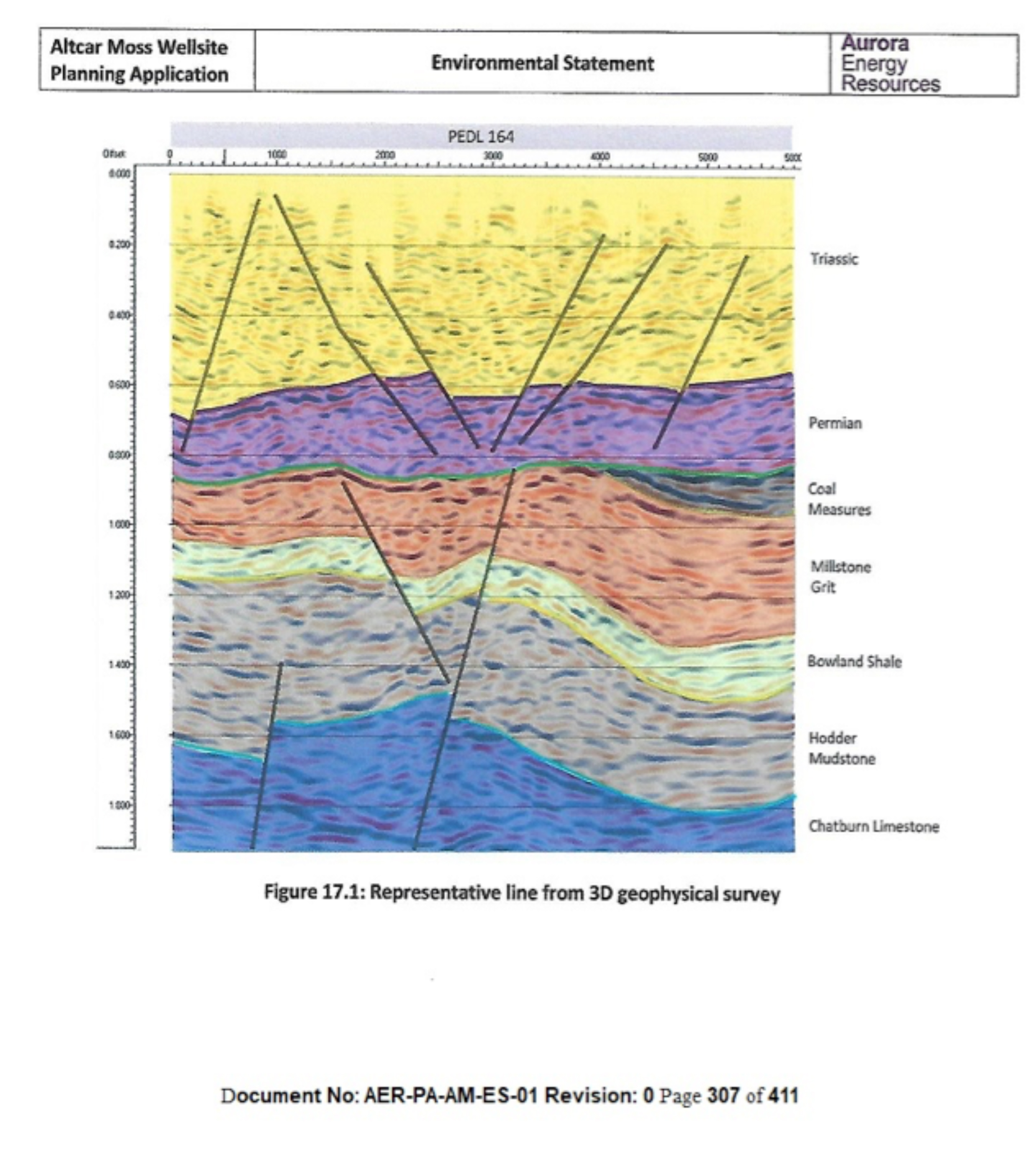 APPENDIX 2
APPENDIX 2
Regional Section around Formby
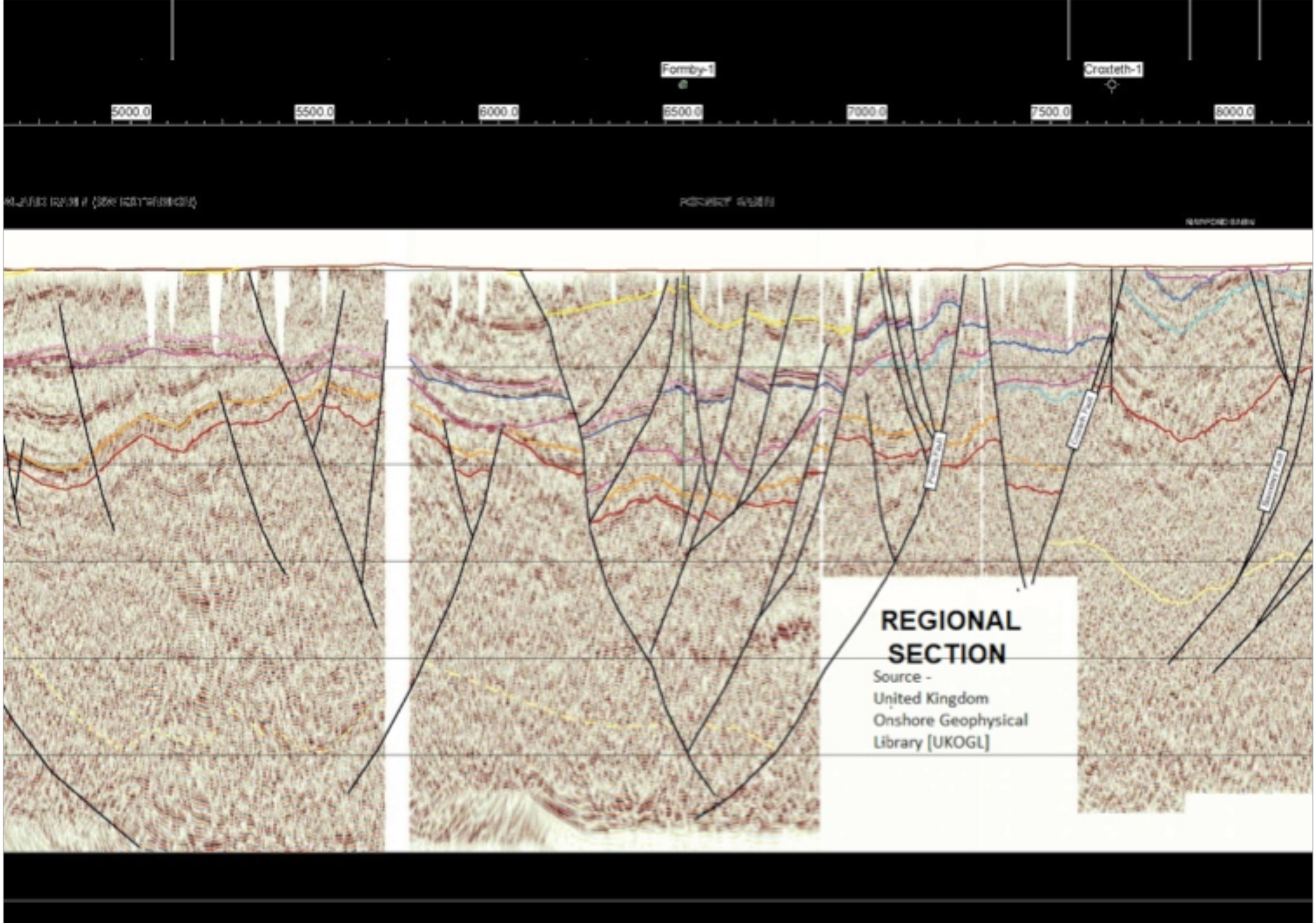
Geoseismic Cross Section near old Formby oilfield
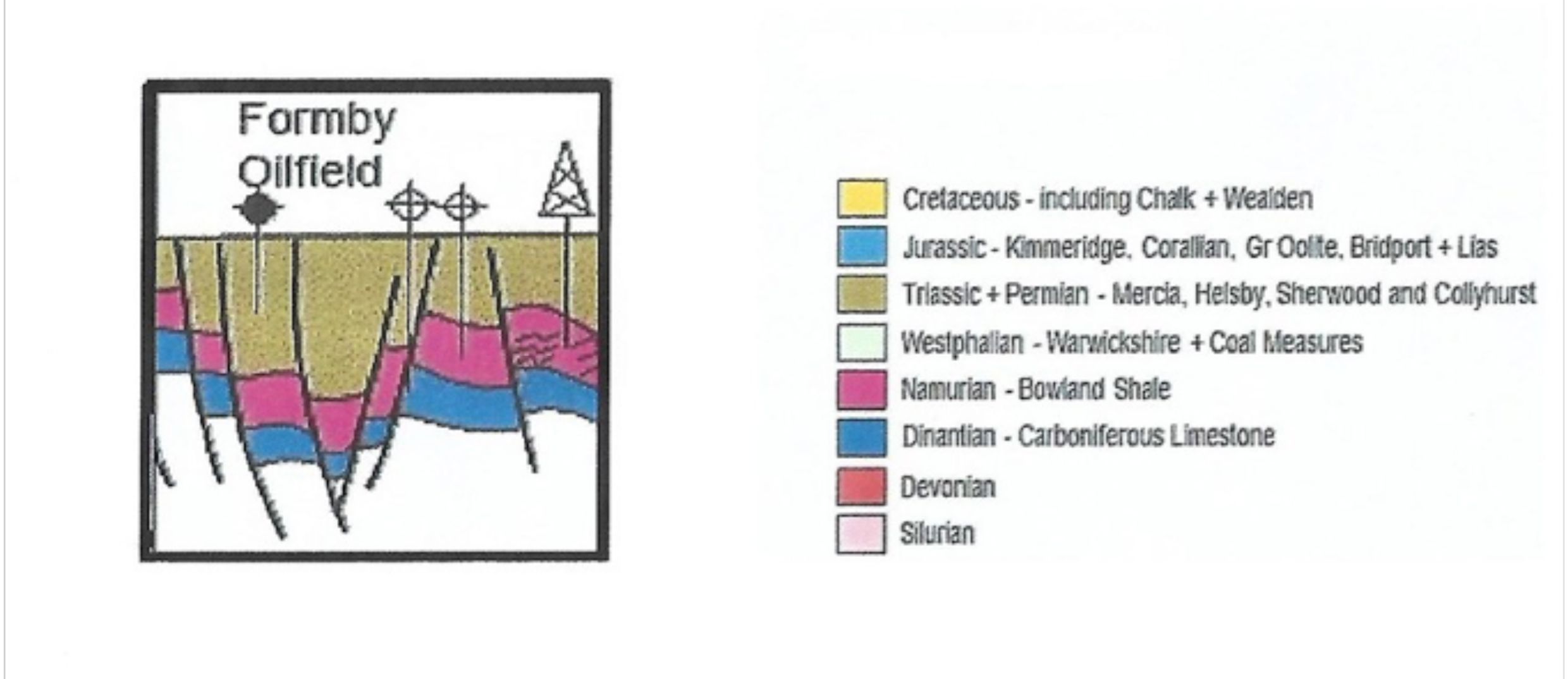
APPENDIX 3
Natural oil seepage in drainage ditches near old Formby oilfield
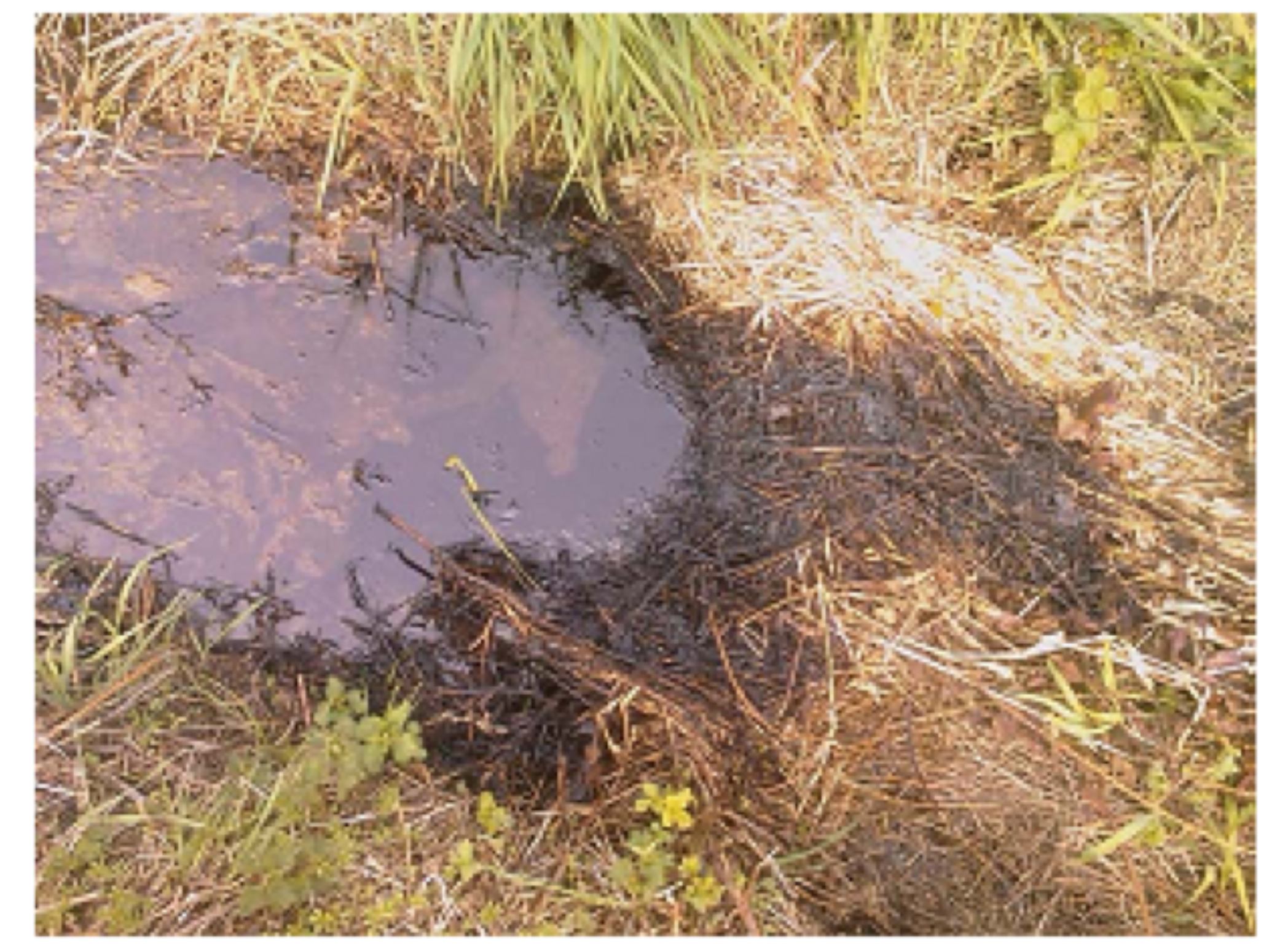
Spring Newsletter 2020
How You Can Still Object
The following information leaflet detailing how you can still object to the proposed fracking site development in Great Altcar can be downloaded as a pdf by clicking here or by clicking anywhere on the image.
For additional information, please see Detailed Objections
Fracking is not Banned
The local application from Aurora Energy to drill a test well at Great Altcar, is not included in the current moratorium. The application is being progressed with Lancashire County Council now..!
Detailed below is information on the current status of the application, together with new deadline dates for objections and a proposed date for Lancashire County Council to meet and consider a ruling on the application.
LATEST NEWS ON AURORA’s PLANNING APPLICATION
Lancashire County Council (LCC) sent a statutory (Regulation 25) letter to Aurora on the 25th October 2019 requesting additional information in support of its planning application to construct fracking wells on a site at Great Altcar. The issues covered largely reflected concerns raised by a number of consultees about a range of aspects of the application i.e.
Wellsite construction (including the intended height of the drilling rig)
Green belt incursion
Ecology
Seismicity
Highways
Archaeology
Climate change
Noise
Groundwater/surface water
Air quality
Despite the impending general election, Aurora apparently provided a comprehensive response (in five parts) to LCC’s Regulation 25 letter on the 9th December 2019. Although such responses from planning applicants would normally be expediently displayed on its planning portal, this did not happen until the 15th January 2020. This was the same day that The Moss Alliance’s objection report was submitted to LCC with a request that it be published online. The recent responses from Aurora can be viewed at the bottom of page 4 of the ‘attachments’ to application reference LCC/2019/0037.
http://planningregister.lancashire.gov.uk/PlanAppDisp.aspx?recno=7359
It is understood that LCC has nominated the 24th February 2020 as the deadline for consultees to respond to the new information from Aurora, and has decided to hold a special meeting of its Development Control Committee tentatively fixed for the 27th March 2020 to determine the planning application.
To that end objections from the public will have to be posted via email, on the planning portal or in writing no later than 6th March 2020. We now urge further support in opposing the planning application by responding to Aurora’s newly submitted responses.
All the local groups (and their consultant advisors) opposed to the planning application are now busily digesting the new information with a view to submitting further objections to the application in due course. You also have the opportunity to sign online petition via 38degrees “fracking at Altcar Moss”.
You can raise an individual objection via:-
1. Email: devcon@lancashire.gov.uk
OR
2. In writing: The Development Management Group, PO Box 100, County Hall, Preston, PR1 0LD.
OR
3. via Lancashire’s planning Portal and follow the link at the bottom of the page
How to have your say then click on make a representation online
In each case please quote reference LCC/2019/0037 and the location. ALTCAR MOSS WELLSITE, SUTTON’S LANE, Great Altcar
Please ensure your letter/email states explicitly “I object” to the application with your own reasons and you include your name, address and postcode.
For additional information, please see Detailed Objections
Fracking Moratorium – Statement from Frack Free Formby
The Government announced on 2nd November 2019, that there is now a moratorium in place on new fracking for shale gas in the UK.
What does this mean to Frack Free Formby and our loyal followers?
A moratorium is just a pause. The same as the one imposed in 2011 when a 2.3 ML seismic event at the Preese Hall fracking site in Lancashire halted fracking and an investigation was carried out. In 2015 that moratorium was lifted allowing Cuadrilla to apply to frack a second site at Preston New Road, Blackpool (PNR1).
There was again seismic activity at PNR1 in 2018 measuring 1.5m. This well was then decommissioned and the Oil and Gas Authority (OGA) commenced an investigation.
Cuadrilla commenced fracking a second well in 2019 (PNR2) which ultimately resulted in seismic activity of 2.9 ML in August 2019 amongst a whole host of smaller magnitude tremors. As a result the fracking has ceased but flow testing is still underway.
The OGA report published today gives the reasons for the seismic activity in 2018 at PNR1, observing that location of faults in the shale and force of injecting fluid caused the seismic events. The data gathered at the 2018 PNR1 well has been used to model predictions of tremors. The report did conclude the OGA cannot generalise the reasons for seismic activity to any other fracking sites in the UK and geology of the UK is variable. They have been modelling the following:
- Seismic events – 2.8 ML classified in their report as Likely;
- Seismic events – 3.5 ML classified as Possible; and
- Seismic events – 4.5 ML classified as Unlikely
This could indicate that the OGA are looking to justify raising the traffic light system to allow for seismic events of 2.5 ML as being acceptable in the fracking process since they are deemed likely. This would be a significant increase on the current regulatory maximum limit (0.5 ML).
The final conclusions by OGA are that all potential fracking sites are geologically specific and that reducing the injection rates could reduce the possibility of seismic events.
More telling are the comments from Andrea Leadsom in an interview on radio on 2nd November:
“The moratorium is very disappointing. What we are announcing today is a moratorium, it is not the same as a ban. There is no doubt that shale gas has huge potential in the UK. This moratorium will be in place till science can make clear what the seismic activity is likely to be with a greater degree of certainty. It is the seismic activity that is the area we need to closely regulate and we need that certainty. So as the science improves we will be able to look at this again but not for now. The idea of a moratorium is to remove uncertainty and to make clear to businesses that we WONT be bringing forward any applications or any further consent for now.”
In our opinion the government had to act on the OGA report which could not give any reassurance that there is a scientific model that predicts the possibility of seismic activity at any fracking site. Also given there is an imminent general election, it appears that anything that halts fracking could be a potential vote winner. Leadsom’s comments make it quite clear the Conservatives are adamant that fracking for shale gas in England still has “huge” potential.
What does this mean for the current application from Aurora?
This is uncertain, it is unlikely to be approved by Lancashire County Council whilst the moratorium is in place but the company may decide to continue to attempt to receive approval in the very probable event that the moratorium is lifted in future especially if the Conservatives win the General Election on 12th December this year.
We will discuss with the Lancashire County Council Planning team next week in conjunction with our planning advisors and will report any key findings and guidance in due course.
We will continue to fight fracking and be prepared to object to any future applications in our area.
Thanks to everyone who supports Frack Free Formby, and for all the hard work from individuals who have helped us during the campaign to object to the Aurora Planning Application to frack at Great Altcar.
How to Object
THE PLANNING APPLICATION FOR A FRACKING SITE AT GREAT ALTCAR HAS BEEN SUBMITTED
This is your chance to object to the development.
Deadline End of December 2019. Take action now..!
(Deadline is provisional subject to Lancashire County Council preferred planning meeting in early 2020)
Five key arguments against Aurora’s planning application are:
- The UK does not need onshore shale gas: Offshore gas and the increasing use of renewables can satisfy the UK’s need for energy and enable us to meet climate change targets, without resorting to fracking.
- Fracking entails environmental risks: Harvesting the shale gas by fracking could lead to earthquakes and air pollution (increasing risks of asthma). Fracking uses massive quantities of water, all of which is wasted. 60% is left in the ground potentially causing toxic contamination of groundwater supplies and eventually the land surface. Any water recovered is contaminated and has to be disposed of.
- Fracking threatens local communities: Fracking can damage properties, impair the health of local residents, threaten local habitat and create traffic problems. There will be a substantial increase in lorries carrying toxic chemicals, water and sand along Formby bypass. There will be a loss of local jobs in agriculture, tourism and service industries.
- The Great Altcar site is unsuitable: The proposed site is close to several fault lines and disused bore holes (see previous article here). Fracking near these faults may cause earth tremors under Formby. The proposed site is a flood defence zone and close to a conservation area, on farmland which is a haven for threatened native birds and over-wintering geese and swans.
- The proposal threatens all of north Sefton and south west Lancashire: To be a commercial success and maximise shale gas recovery, many more wells and well pads will need to be built. This might include drilling under Formby and the pinewoods and sandhills. We will lose farmland on a massive scale.
For further detailed objections against Aurora’s planning application please click here and…
For background information to the objections, please click here.
PLEASE OBJECT AND SAVE YOUR COMMUNITY.
TAKE ACTION NOW..!
Email: devcon@lancashire.gov.uk
Or write to:
The Development Management Group,
PO Box 100
County Hall
Preston
PR1 0LD
Quoting ref: LCC/2019/0037 and the location ALTCAR MOSS WELLSITE, SUTTONS LANE, GREAT ALTCAR
Or follow this link to the planning application and click on ‘How to have your say’ and then ‘make a representation online’.
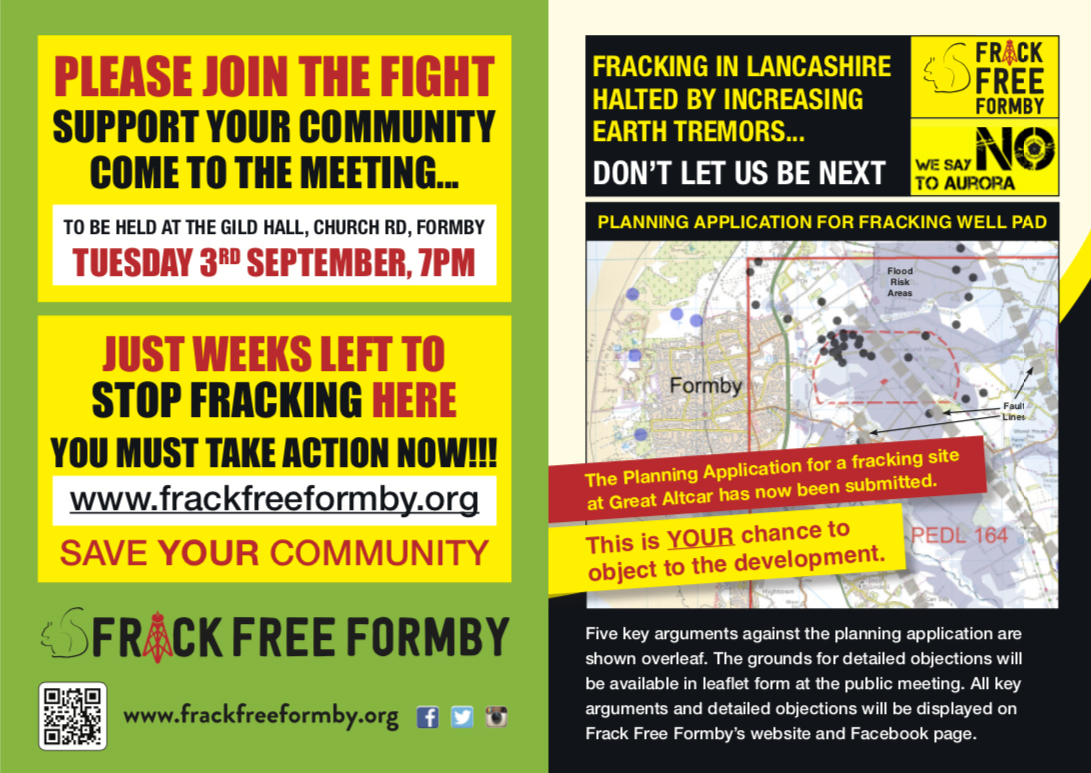
For a PDF printable version of this leaflet, please click Planning Application Leaflet
Risks of Raising Red Traffic Light Limit
Concerted efforts are being made by fracking operators and ‘geoscientists’ to persuade the government to increase the red traffic light limit from 0.5M to 1.5M. The Times newspaper recently published a letter by 49 ‘geoscientists’ urging the government to commission an urgent review of the fracking earthquake limit, recommending this be raised to allow the industry to expand. However, as revealed by Channel 4 News, many of these ‘geoscientists’ have direct connections to the oil and gas industry.
Current Oil and Gas Authority guidelines state that upon detection of an earth tremor of magnitude 0.5 the “…Operator[s] must suspend injection, reduce pressure and monitor seismicity and ground motion for any further events before potentially resuming.” When a seismic event of this magnitude occurs, fracking operations must cease for 18 hours while the well is flushed out and its integrity checked.
The main arguments being used to raise this limit to magnitude 1.5 are that:
- the current red-light limit prevents effective fracturing and gas release
- higher limits work satisfactorily in other countries, and other UK industries
- the proposed level cannot be felt on the surface and causes no damage.
The responsible Minister (Claire Perry) recently said that she is resisting the change and has no plans to implement it. Yet six months ago she wrote to a fellow MP saying “that the monitoring system was set at an explicitly cautious level…. (and) as we gain experience in applying these measures, the trigger levels can be adjusted upwards without compromising the effectiveness of the controls.”
Seismic events occur when fault lines are lubricated, and plates slip. In this context, opponents of fracking point out that the UK has 400 times as many fault lines as the USA. Furthermore, as the UK is far more densely populated, fracking wells will inevitably be sited much closer to housing areas. They are also concerned that fracking operators’ surveys fail to pick up small fault lines, and that they are permitted to frack too close to detected faults.
Fracking opponents argue that the Preese Hall experience shows the risk of increasing the traffic light limit. The well was sunk 200 metres away from a small (unidentified) fault line. Fracking caused 58 earthquakes between March and May 2011 (de Pater and Baish 2011), the largest being 2.3M on the 1st April and the last being 1.5M on the 27th May. This latter event deformed the bottom 170 metres of the well (making it ovoid instead of round).
Operations were suspended and the well was plugged with concrete in 2013 and abandoned, but had to be replugged two years later. This reflects concerns that disused steel casings are liable to rot over time, and the concrete linings shrink and crack. These events could provide a potential upward conduit for fugitive emissions of released but unrecovered gas and fluid, contaminating groundwater resources and the surrounding land surface.
Operators have clearly been using low hydraulic pressure in order to try to comply with the current red traffic light – yet by so doing have inadvertently triggered seismic events well above this level. Lifting the limit will enable them to apply greater hydraulic pressure in order to release the gas – but risks triggering seismic events on a much larger scale than previously encountered in the UK due to Fracking.
References
Channel 4 News 15 February 2019
de Pater, C.J. and Baisch, S. (2011) Geomechanical Study of Bowland Shale Seismicity: Synthesis Report
Refracktion (2019) Don’t Mess with the Traffic Light System
The Times Newspaper 9 February 2019
Geological Concerns Regarding Fracking Regulation
The UK system of regulation of fracking imposes a range of strict geological controls on operators – including seismic surveys, safe distances, seismic monitoring, a traffic light system, and barriers to fugitive migration.
Experience and professional advice suggest however that each of these controls is flawed i.e.
- Seismic surveys are invariably incomplete and incapable of detecting small fault lines and minor vertical displacement which could lead to earthquakes.
- The EA formula for calculating a safe distance between fracking propagation and fault lines is unduly optimistic and should be replaced by a minimum distance of at least 850 metres horizontally.
- The sequence of events at both the Preese Hall and PNR sites implies inherent instability in the stress planes of the fault lines in the Bowland Field.
- Fracture growth monitoring is inadequate to indicate the precise real time effect fracking is having on the propagated area.
- The combined effect of these factors is to automatically trigger the temporary suspension of drilling under the current traffic light system, an outcome which is incompatible with commercial considerations.
- The current traffic light system also fails to accommodate measures to deal with large seismic events, swarms of seismic events, or trailing events.
- Increasing the current red-light limit from 0.5 to 2.0 ML threatens well integrity and fluid migration into unprotected formations.
- The higher red-light figure is equivalent to the energy release of 1 metric ton of TNT explosive, the size of a late WW2 bomb.
- The regulatory controls will not detect the fugitive migration of released but unrecovered gas/fluids through pathways and conduits, and
- The claimed barriers to prevent sideways and upward migration of gas/fluids and the potential pollution of groundwater resources are ineffective.
References
Joanne Hawkins (Bristol -> Leeds University) Fracking – minding the gaps March 2015 [Supports general theme]
Professor David Smythe (Glasgow University) Objection to PNR and Roseacre planning applications September 2014 Submission to Scottish Government May 2017 [Supports points 1, 2, 9 & 10]
Professor Peter Styles (Keele University) Fracking and historic coal mining April 2018 [Supports points 1 & 2]
Professor Fred Worral & Miles Wilson (Durham University) Professor Richard Davies & Sam Almond (Newcastle University) Fracking – how far from faults? August 2018 [Supports points 2 & 4]
Shawn Maxwell (ex Keele University) What Does Microseismic Tell Us About Hydraulic Fracture Deformation? Oct 2011 [Supports point 4]
National Institute of Disaster Management, New Delhi Earthquake measurements paper to East Asia Summit [Supports point 8]

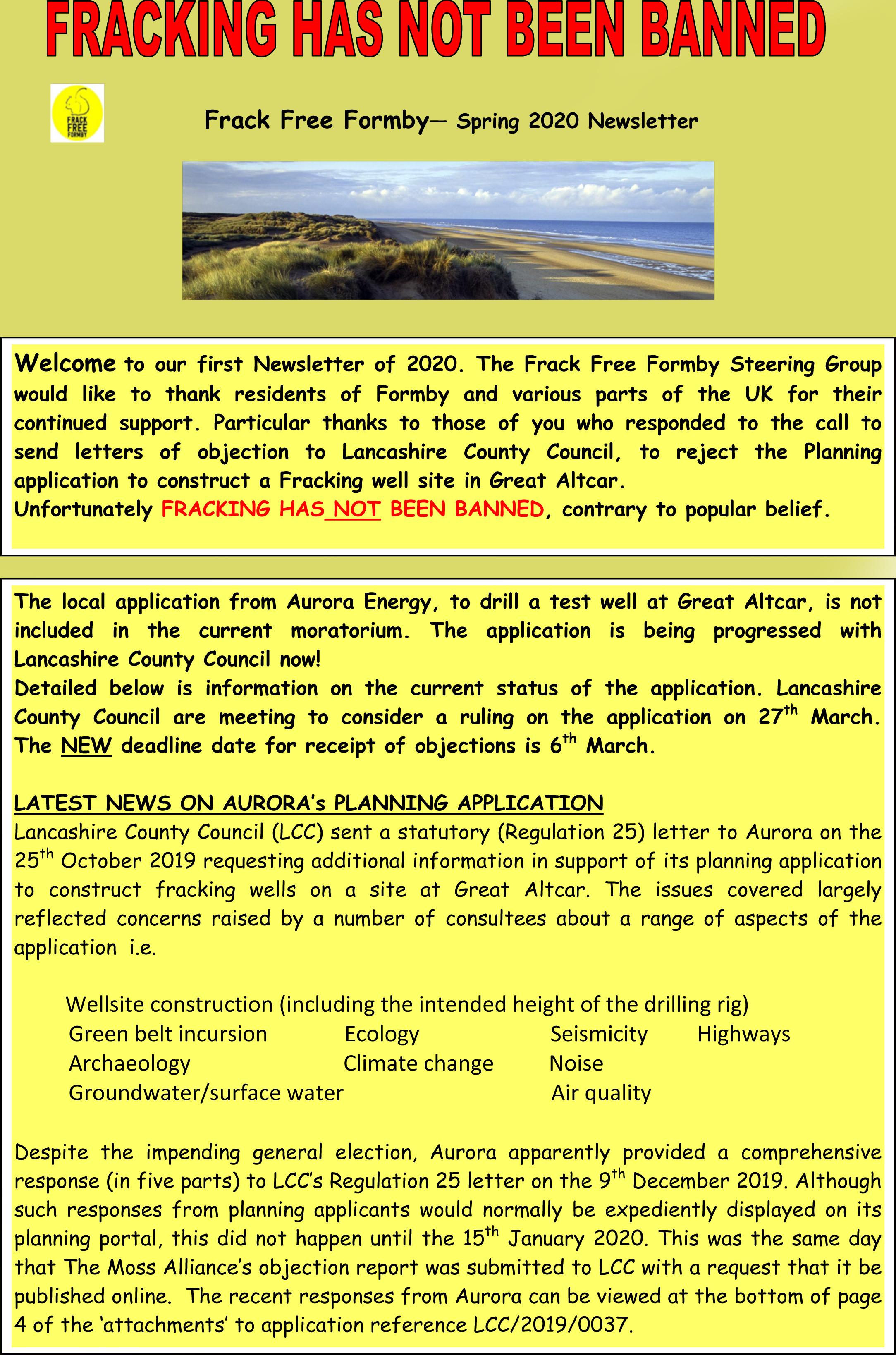


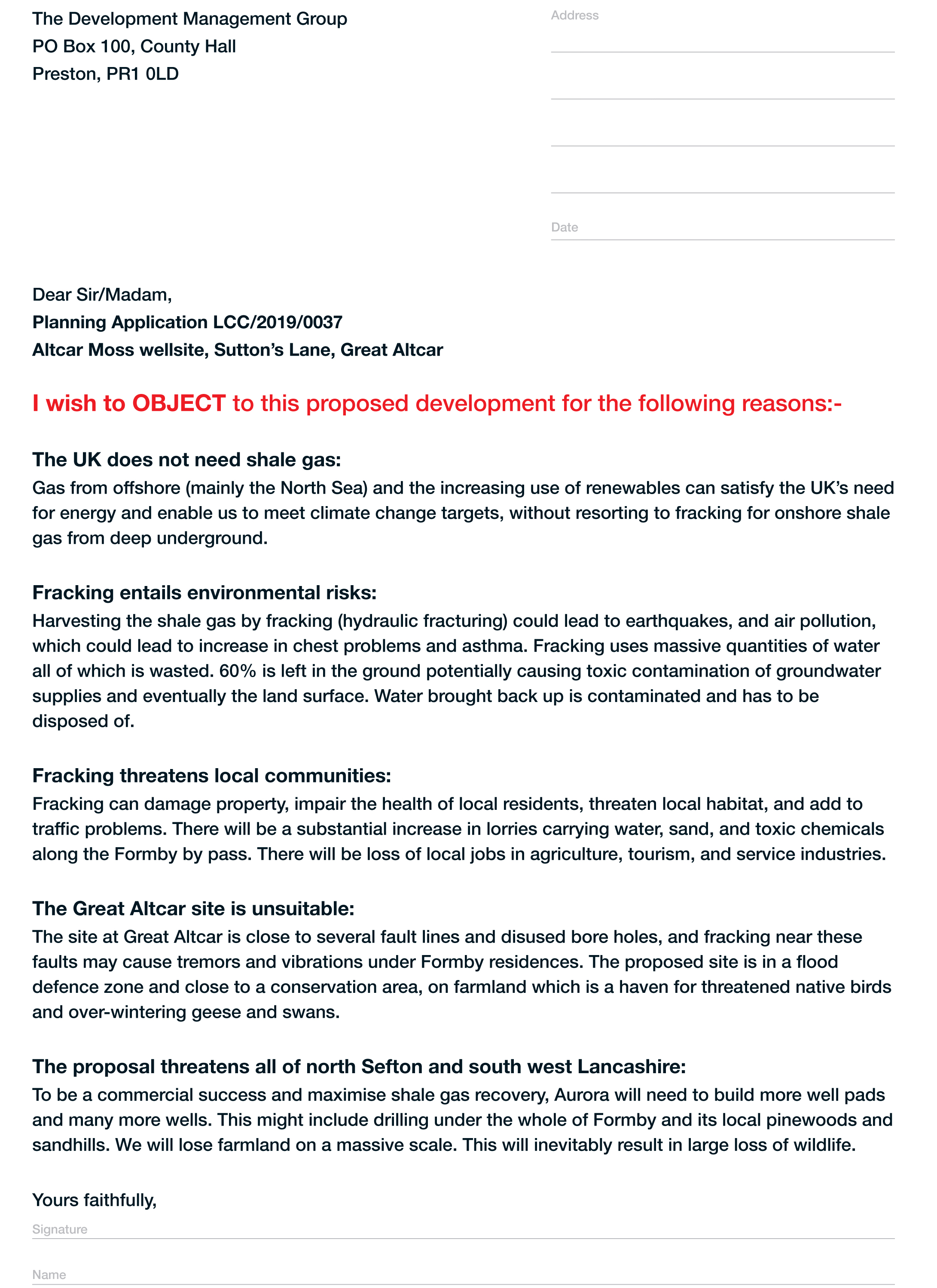

You must be logged in to post a comment.